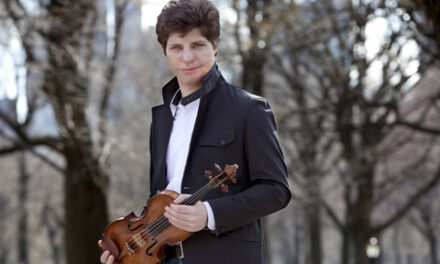The large student orchestra (including ten contra-basses!) under the direction of departing Maestro James Allbritten paid tribute to the memory of the UNC School of the Arts‘ first Chancellor, Robert Ward, who passed away one year ago at age 95. The program, presented in the lovely Stevens Center in downtown Winston-Salem, included two works by the much loved Ward and one by Aaron Copland, with whom Ward studied in 1941 at Tanglewood, as well as the recent (2013) Triple Concerto by one of Ward’s more successful students, Kenneth Frazelle, currently a composition teacher at UNCSA.
The concert opened with a work of maturity, “By the Way of Memories: A Nocturne for Orchestra” (1987). This gentle and lyrical work in one movement stays in a lilting three beats to a measure and includes some of Ward’s signature harmonic progressions, lovely woodwind and horn writing, and a jazzy 13th chord to close.
Kenneth Frazelle (whose music is reviewed here and here) studied with Robert Ward while a high school student at NCSA (as it was known then), before attending the Juilliard School, where he studied with Roger Sessions. Frazelle was commissioned to compose the Triple Concerto (2013) by Eric Larsen, the Director of the prestigious Meadowmount School of Music, a summer music school situated in the Adirondack Mountains of New York. In the winter, Larsen teaches piano at UNCSA. He was joined for this performance by Kevin Lawrence, violin, and Brooks Whitehouse, cello, both faculty members at UNCSA.
As Meadowmount caters only to string players and pianists, the concerto has no wind, brass, or percussion, only strings. Indeed, the opening, pitting the piano in an angular fashion against the low sustained strings immediately brought to mind the colors of the opening of Ernest Bloch’s Concerto Grosso No. 1. But there the similarity ends, for Frazelle uses many modern innovations in his string writing – bouncing the wood of the bows on the strings (col legno) and snap pizzicato in the low strings (pioneered by Mahler and frequently used by Bartók). There is a dramatic pause near the end of the first movement (Allegro maestoso), after which Eric Larsen whimsically played what seems like an improvisation – to great effect.
I particularly liked the second movement (Variations) with its deep and dark cello and bass writing, rising pizzicato, and interwoven filigree by the soloists over the lyrical orchestra. Here the lush tones of Lawrence and Whitehouse shone. This movement has a momentously satisfying climax before yielding to a lively last movement, a sort of moto perpetuo in 5/8 rhythm, Molto vivace . In his oral program notes, Frazelle likened this movement to a “dog chasing its tail!” And there is a super strong ending which brought the audience to its feet.
Opening the second half of the concert, Aaron Copland’s charming and delicate “Letter from Home,” written in 1944 on a commission from Paul Whiteman, featured some lovely trumpet playing by Stephanie Shields. Mirroring the character of the opening nocturne by Robert Ward, the Copland also served as the perfect foil for the robust and energetic Symphony No. 2 by Ward, which closed the concert.
One of Ward’s most frequently played compositions, the symphony, written in 1947, comprises three movements. The first movement, marked Fast and Energetic is just that, using mixed meters and a six-note theme in a minor key. The orchestra was crisp and precise and there were some outstanding wind solos from Jessica Appolinario, horn, Cody Dean, bassoon, and John Hammarback, oboe. Dissonant chords over a held trumpet pedal ushered in the conclusion of the movement. The second movement, marked Slowly, places an eerie orchestration over pizzicato in the bass. The orchestra built up to a well-balanced and well-orchestrated climax before closing on a beautifully played horn trio. The Finale (Fast), in a triplet rhythm beaten in one, is full of bold and glorious moments; it was followed by enthusiastic applause for the outstanding job accomplished by the student orchestra. It is a tribute to the competence of Maestro Allbritten that the orchestra plays so well for him and a fitting testimony to the legacy of Robert Ward.











